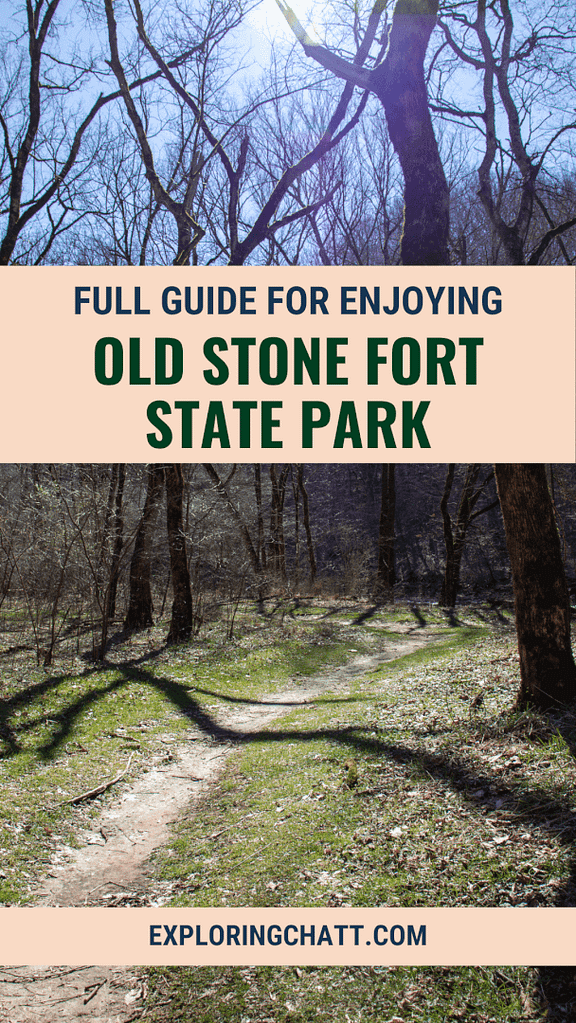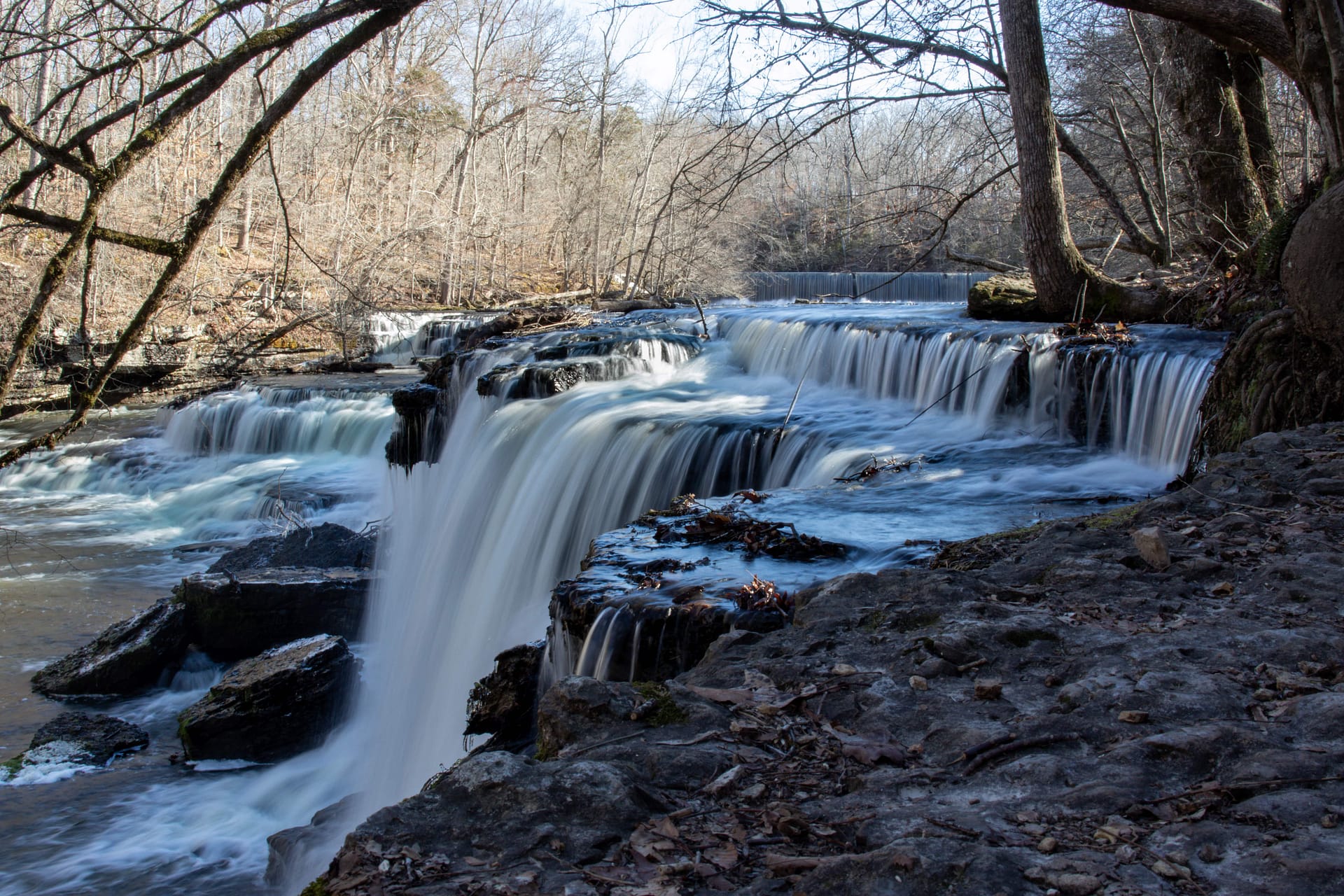Old Stone Fort State Park is one of Tennessee’s secrets because it’s home to some of the best waterfalls and hardly anyone seems to know.
If you’ve lived in Chattanooga for some time and love to get outside, you’ve most likely hiked to Foster or Greeter Falls, visited Fall Creek Falls State Park, and hiked to see Cherokee and Hemlock Falls in Cloudland Canyon State Park. But have you been to Old Stone Fort State Park? This place has been on my list for a while and it’s shocking I waited so long because it’s conveniently close to I-24 in Manchester, TN. Keep reading to learn more about this Tennessee state park immersed in history and covered in waterfalls.
In a hurry? Pin this post for later:


Old Stone Fort State Park
Founded in 1966, Old Stone Fort State Park is a 400-acre archaeological park. It’s surrounded by both Duck and Little Duck River, and both rivers fork at the back of the park. Due to the rivers, the park is on a peninsula jutting out to meet the rivers that surround it. Throughout the park are roughly 5 miles of hiking trails, a few places where you can walk right up to the water’s edge, and 3 named waterfalls. At the center of the park is a 50-acre field within the walls that are known as the Old Stone Fort.

What is the Old Stone Fort?
Honestly, this is the question I asked myself the entire time that I was there. Because looking at the landscape, it’s easy to dismiss this as natural land, untouched by human interference in the way that it’s shaped. However, archaeologists found that rock walls are buried beneath centuries of dirt. And based on historical documents, everything points to a rock mound shaped wall being built around the field by the natives of this land. The rock wall, buried beneath the dirt, spans about 4,600 feet in total length and was built by hand hundreds of years ago.
With a large field at the center, encompassed by the Old Stone Fort, it is presumed that this place was built for sacred ceremonial reasons by the people that once inhabited this land. The name “Old Stone Fort” was given to this mysterious wall by settlers in the early 1800s when they discovered the walls and noticed the openings or gates and trenches or moats as part of it. They concluded that it must have been an old fort, hence the name. The area became popular for hydropower with mills due to the rivers that surround the peninsula. By the mid-1800s when the Civil War broke out, this area also became a prime location for producing gunpowder for the confederate troops. And after the war, in the late 1800s, a couple of families turned the area into a paper mill location. Even though the paper mill didn’t last long, some of the remains can still be seen in the park. In the early 1900s farmers used the field in the center of the land for crops and livestock. But in 1966 Old Stone Fort State Park was born as a conservation effort for this historical spot.


Old Stone Fort Museum
When you first enter the park, you’ll follow the driveway to the back and find a parking spot in the area. Follow the sidewalk up and you’ll find the Old Stone Fort Museum on the right side, along Duck River. Inside you’ll find a help desk, souvenirs, restrooms, and a small museum all about the Old Stone Fort history and archaeological research. Not only does this museum briefly explain the origins of the Old Stone Fort, but it also covers the importance this land had in the Civil War, industrial times, and the native wildlife you might find here. Outside the museum you can walk on top of it and overlook Duck River and a small dam.




The Hiking Trails of Old Stone State Park
Old Stone Fort State Park has a few different hiking trails to note. Learn more about each below.
Enclosure Trail
The Enclosure Trail is the main trail of the park. It’s a full circle hiking trail that basically takes you on the top of the mound wall that creates the Old Stone Fort. The trail is nearly 1.5 miles long and is fairly flat and easy to hike with minimal elevation change. There’s also plenty of plaques along the way to tell you more about the stone wall, history from the Civil War, and the mills that used to be here. This trail will also take you by the three waterfalls. If you only have time to hike one trail in this park, make it this one.


Forks of the River Trail
The Forks Trail, or Forks of the River Trail, is a short loop trail that starts around the halfway point off the backside of the Enclosure Trail. This .3 mile trail simply takes you down to where Duck River and Little Duck River fork into three different directions and back up to the Moat Trail.

Moat Trail
The Moat Trail follows the old riverbed that is presumed to be part of where the Duck River flowed before the creation of the rock wall making the Old Stone Fort. Moat Trail connects the Forks Trail with the Enclosure Trail in a short .45 mile hike.
Backbone Trail
The Backbone Trail is the most difficult trail in the park, but it’s truly not that difficult compared to other hiking trails in the area. This trail has the most elevation change as it follows the outline of the secondary finger of the peninsula, just past the Forks Trail. There’s a small ridge that this trail climbs, hikes across, and descends on the other end, making this hike more strenuous than the rest, but it’s only a couple hundred feet of elevation gain and loss. The Backbone Trail is also prone to erosion as half of it hugs the river’s edge, so be mindful of this if you attempt this trail.



Campground Trails
There are two additional trails at the campground called the Garrison Road Trail and Nature Trail. Both are just over .75 miles long and also fairly easy to hike, from what I’ve read. I have not hiked these trails myself yet, but I will update this post with my conclusions once I do.
Waterfalls at Old Stone Fort State Park
Three named waterfalls can be enjoyed at Old Stone Fort State Park. These waterfalls are all considered “multi-step” or “tiered” waterfalls because they are made up of a series of smaller waterfalls that step down the river. Below is more information about each of them.
Blue Hole Falls
Blue Hole Falls is located downstream on Duck River, not too far down the trail behind the museum. From the Enclosure Trail, you can carefully make your way down to see the falls up close. And in the distance, above the waterfall, you can see the dam that is beside the museum upstream.

Big Falls
Big Falls is located on Duck River as well, but a little further downstream. It consists of a smaller waterfall followed by a larger waterfall as they step down the river. Again, you can access this waterfall from the Enclosure Trail. Just proceed with caution.



Step Falls or Little Falls
The final waterfall is either called Step Falls or Little Falls, depending on who you ask. This waterfall is again a series of small waterfalls adding up to a bigger waterfall. Out of the three waterfalls, this one probably has the most changing steps, hence the first name. It’s located on Little Duck River, hence the secondary name, and is not too far from the museum on the other side of the loop of the Enclosure Trail.


Tips for Visiting Old Stone Fort State Park
Hike Clockwise
First of all, the Enclosure Trail is hard to follow. So many additional trails have been carved in the area making it difficult to tell which one is the official trail and which ones are just extra. This issue appears to only be on the right side of the loop, directly behind the museum. So, if you start your hike by going counterclockwise around the Enclosure Trail, you’ll run into this issue.
For the sake of confusion, I recommend hiking this park clockwise. It’s easier to navigate the trails, see signs, and even the waterfalls will be facing you if you approach the hike this way. Even if you hike the trails in the back of the park (Forks, Moat, and Backbone) you’ll find that going clockwise might be easier too.

Watch the Terrain
As mentioned earlier, part of the Backbone Trail is heavily eroded away, so if you decide to hike this trail, proceed with caution. When you go down to visit the waterfalls up close off the side of the Enclosure Trail, be mindful of the cliffs and slippery rocks. The day I went, it had been below freezing the night before so there was still ice on the rocks near the waterfalls. And at Step Falls or Little Falls, the jaunt trail that takes you down to the waterfall is on a cliff edge for part of the way.
Below is a map I made for you to better describe the park and what to expect based on my most recent exploration here.

Swimming Holes
I wouldn’t swim here. Or at least that was my thought process after visiting in peak waterfall season when the water is raging, and the current is strong. However, in the summer months the water can be calmer and make swimming spots more feasible. I didn’t notice any signs saying to stay out of the water, and I’ve read that there’s swimming holes along here that are popular with summer visitors. Just be mindful that the waterfalls are not singular and come with a series of more waterfalls. There’s also spots that look like beaches that you could easily wade into as well, but both Duck River and Little Duck River can have strong currents and get deep in the center at times. So, proceed with caution if you decide to try swimming here.


Closing Thoughts
Old Stone Fort State Park is full of history and holds so much beauty in its scenery and rivers. I’m amazed at how easy it is to fully access the waterfalls and enjoy everything this archaeological park has to offer.
For the video version of my first visit to Old Stone Fort State Park, you can view it on YouTube. Let me know in the comments below if you’ve visited this park before and what your thoughts are. Maybe one day I’ll camp here and get to enjoy the other trails too. Until next time, enjoy exploring Chatt!

More Waterfall Hikes to Visit Near I-24 Headed West from Chattanooga:
Inspired? Pin this post for later:



Ty Amanda:
I truly enjoyed your article and am looking forward to reading your guides as I am planning on visiting this area next year for waterfall exploration.
Steve
Thanks Steve! I appreciate the feedback and hope that the waterfalls are flowing beautifully when you visit next year!